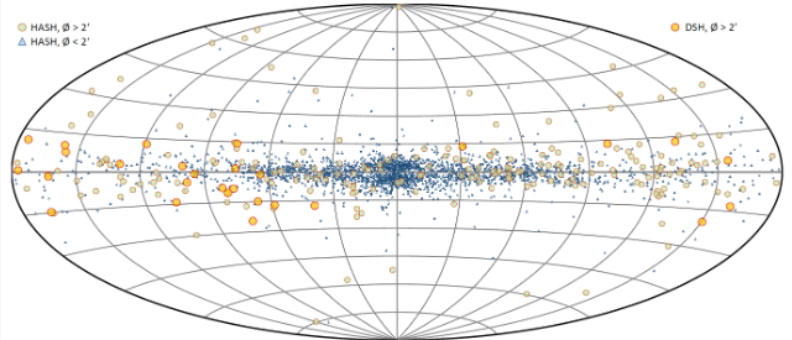| | Medium- to large-sized True and Likely planetary nebulae from the DSH sample | | | |  | | Fig1: Distribution of True and Likely PNe from the DSH sample with Ø > 2? in an Aitoff?Hammer projection of the Galactic Plane. Other True and Likely PNe listed in the HASH database are shown for comparison. The average scale heights of the DSH and HASH samples with Ø > 2? are 10.0° and 11.4°, with RMS dispersions of 11.8° and 18.8°, respectively. |
| | Introduction
The Hong Kong/AAO/Strasbourg H? planetary nebula database (HASH) [1] incorporates almost 300 true, probable and possible planetary nebulae (PNe) that have been identified since 2003 within the framework of the Deep Sky Hunters (DSH) project, and other amateur-based efforts [2-4]. Our sample covers all types of different PN morphologies, spectral properties, and evolutionary states. Estimated distances range from below 1kpc to extragalactic. This contribution focuses on all currently known medium- to large-sized PNe and candidates (optical diam > 2? ) in our sample.
| | Results
The table below summarizes all 28 True (T) and Likely (L) PNe from the DSH sample with optical diameters > 2? and lists the fundamental properties of the nebular shells and the CSPNe. Previously unpublished objects are highlighted in blue. Statistically derived distances were taken from [5]. The listed CSPN magnitudes were extracted from PanStarrs photometry. For 15 objects with available UV, optical and IR photometry, we determined E(B-V) and T by fitting the spectral distributions of the CSPNe with distribution functions of blackbody emitters corrected for the effects of interstellar extinction using the formalism in [6] and assuming RV = 3.1. The GALEX UV fluxes were corrected by applying the revised photometric calibration from [7]. Effective wavelengths and zero points were taken from various resources. We note that two CSPNe (Pa 161 and Pa 153) have composite distribution functions with a hotter and a cooler component.
| | | Sources et liens
Version PDF (et complète) du poster: cliquer ici
Liste de tous les articles: Cliquer ici | |
|
|